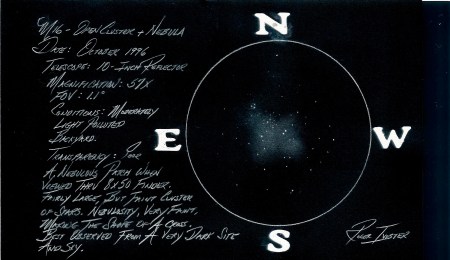Pencil sketch using a blank 5 x 8 notecard, with the colors inverted using a scanner

Original pencil sketch with natural colors
August 2015 – Observer’s Challenge Report: Click on the following link.
AUGUST 2015 OBSERVERS CHALLENGE – M-016
M16 – NGC 6611: Open cluster and nebula in Serpens, often called “The Eagle”
Date: October 1996
Telescope: 10-inch reflector
Sketch: Magnification 57x and field of view 1.1º
Conditions: Transparency Poor – NELM 5.0
Location: Moderately light polluted backyard
About 30 mostly faint stars could be counted, with a greater concentration on the NNW edge. A pair of 8th magnitude stars located on the W side. A faint and small triangle of mostly equal stars located just outside the nebula on the NNE edge. The nebula is mostly faint. When using averted vision and patience, the nebula makes a cross shape, as seen in the following pencil sketch. Easily seen with an 8 x 50 finder appearing as a faint nebulous patch.
My backyard is a poor location to observe this object, as ambient lighting from a couple unshielded streetlights are located in close proximity to my observing site. This object would be best observed from a true dark site and with the use of an O-III or UHC filter.
3.5-inch Maksutov-Cassegrain
Date: September 1997
Magnification: 52x
About 15 stars counted, with a prominent double star located on the western edge. The surrounding nebula is very faint and appears without a definite shape, encompassing the cluster. A faint and small triangle of stars is located on N edge.
Roger Ivester
Following image by Dr. James Dire of Hawaii:
“My image of M16 was taken with a 4-inch apochromatic refractor at f/6.3. The exposure was 90 minutes with an SBIG ST-2000XCM single shot color CCD camera. Even with this small aperture, dark dusty pillars of gas are easily seen. These are the types of pillars magnificently imaged and made famous by the Hubble Space Telescope. The red glowing hydrogen gas does take the shape of an eagle. Faint glowing gases extending beyond The Eagle are part of a larger complex, which includes the neighbor M17 nebula.” JD
Pencil sketch by Jaakko Saloranta of Finland using a 4.5-inch Newtonian reflector @ 101x with a FOV of 30 arc minutes:






Recent Comments